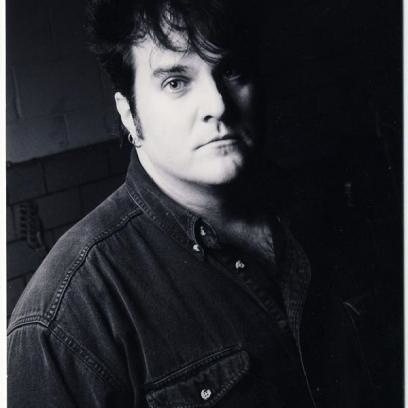 Alright, all you moms and dads out there… Let’s say your little baby just graduated from high school with no apparent ambition other than music. Then some glassy-eyed jamband guitarist/tabla player tries to convince you that your kid, who now goes by the name Moonflower, should run off with their peyote-fueled traveling circus.
Alright, all you moms and dads out there… Let’s say your little baby just graduated from high school with no apparent ambition other than music. Then some glassy-eyed jamband guitarist/tabla player tries to convince you that your kid, who now goes by the name Moonflower, should run off with their peyote-fueled traveling circus.
The correct answer is, of course, yes… but not without subjecting Moonflower to a stern lecture – actually, a series of lectures at Cuyahoga Community College in Cleveland – from the original Rock and Roll Mercenary, Marky Ray.
As Marky knows better than anyone, the business of rock isn’t for sissies. He’s seen it from every conceivable angle – guitarist, bassist, keyboard player, singer, roadie, show producer/coordinator, tour manager, emcee, stuntman, publicist, consultant… I won’t share his entire resume, but following are just a few highlights:
- As a performer: Johnny Action and the Treadmills, Johnny Clampett and the Walkers, the terrible parade, Death on a Stick, The Lyres, The New Salem Witch Hunters, Death of Samantha, The Jim Rose Circus, 3D, solo artist.
- As a road crew member and auxiliary performer (guitar/bass/vocals): Nine Inch Nails, Ministry, Butthole Surfers, Toadies, Die Warzau, Lollapalooza Tour (’91-92 – backing vocals), Pearl Jam, Soundgarden, emcee for Jesus and Mary Chain and Lush.
A native of Cleveland, Marky emerged from its fertile punk seen in the early Eighties, back when the Cleveland Heights/Coventry neighborhood served as ground zero for local rocker misfits. Marky might’ve been the biggest misfit of all. In 1982, he’d just been thrown out of a Quaker boarding school and was developing a taste for virtually every banned substance.
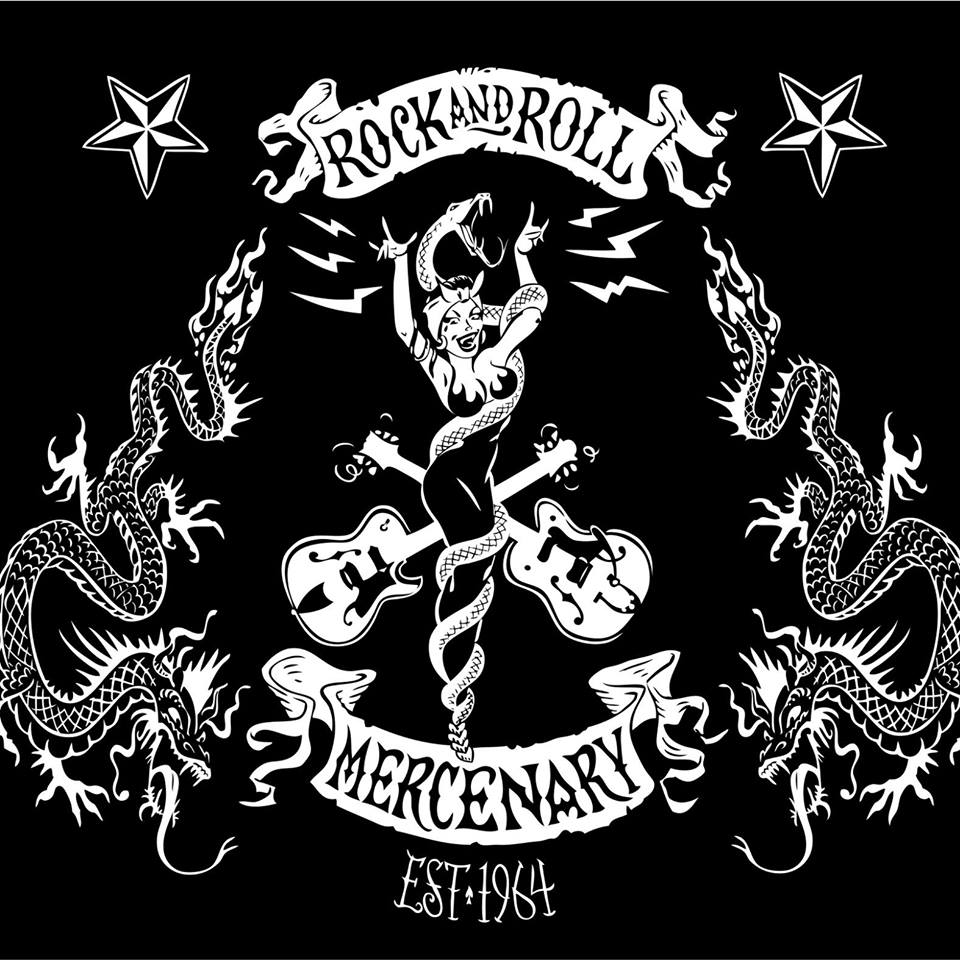 Although his ears were wide open (everything from rockabilly to blues to jazz), punk rock was his salvation, and he threw himself into the local scene with total commitment. There was no Plan B, but he also was determined to prove himself as indispensable to any self-respecting front-person. In other words, he quickly learned how to elevate a wide range of musical projects – whether it involved the perfect guitar riff or vocal harmony, or taking care of business backstage with the many technical, production and tour management skills he’s honed over the years.
Although his ears were wide open (everything from rockabilly to blues to jazz), punk rock was his salvation, and he threw himself into the local scene with total commitment. There was no Plan B, but he also was determined to prove himself as indispensable to any self-respecting front-person. In other words, he quickly learned how to elevate a wide range of musical projects – whether it involved the perfect guitar riff or vocal harmony, or taking care of business backstage with the many technical, production and tour management skills he’s honed over the years.
In the interview that follows, I’ll let Marky (now a substance-free family man) describe some of his major influences and the bizarre twists and turns his career has taken over the last three decades. But I should point out that he currently draws from a wealth of experience – and a seemingly bottomless pit of enthusiasm – to teach Concert Technical Production at Tri-C. His “classroom” is Cleveland’s finest rock club, the Beachland Ballroom, where his students get a firsthand look at what should go right (and everything that can go wrong) in live performance. He’s also the author of Rock and Roll Mercenary, “a layman’s guide on how to crawl your way into the music and entertainment industries.”
Fair warning: This is easily our longest post. But Marky gave us a fascinating look at NE Ohio rock ‘n roll history and his own unique and underrated role in it (a love letter to roadies/techies everywhere!). Definitely worth your time if you’ve got a little to spare.
TQ: Give us an idea of what the Cleveland alternative music scene was like in the early Eighties. What were some of your main influences when you started playing in local clubs and eventually formed the Johnny Action band?
MR: Well, I was pretty stung by the recent events that had occurred in my life at the time. I went from living in a small community of people to living in a big city in a matter of days. I moved in with a good friend who had also been kicked out of that same school. We were punks basically, iconoclasts; we didn’t really give a rat’s ass about a lot of things at that point in our lives other than music. We were fortunate – our parents were very socially liberal, and we had basically been living on our own since we were 14 years old. So we found a studio apartment and finished high school at an alternative school in Cleveland. We lived on Coventry Road in Cleveland Heights, which at the time was kind of the place to be. We spent every dollar we had on records at the Record Exchange dollar bins and Record Revolution, much to the chagrin of our parents.
Backing up a bit here… I was born in Cleveland in 1964. My parents moved to Hudson, OH in ‘69 when my dad got a job teaching at Kent State. I remember when the shootings happened – it had an extremely profound effect on me. I remember it like it was yesterday… I think it made me the anti-establishment punk that I am today. Even today, when I see that historic headline “Four Bums Killed at Kent State,” it makes my blood boil.
Anyway, when we were attending said boarding school from 1978 to ’82, we were well aware of punk, new wave and other musical forms. As I stated earlier, our parents were very big influences in our lives. Both of my parents were educators. My dad (rest in peace) was a big jazz guy – a ragtime piano player himself. From the time I was a baby, I was listening to “Pops” Armstrong, Sidney Bechet, Jellyroll Morton, Fats Waller and others. He also loved R&B, Fats Domino, early rock and roll… and he really loved The Beatles. My father was an aspiring songwriter, and he really appreciated The Beatles’ talents, especially McCartney’s knack for melodies. My mother (rest her soul) was an avid classical music lover with a bent toward the classic songwriting of Irving Berlin, George and Ira Gershwin and Souza’s marches, but she also dug The Beatles and Joan Baez. My Ma had a wicked sense of humor, and I am forever indebted to her for turning me on to the great Tom Lehrer!
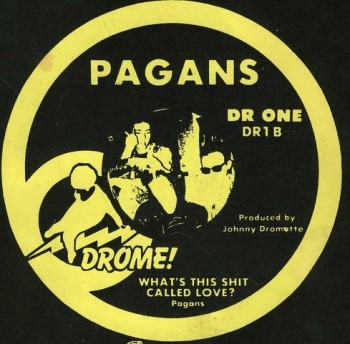 I started collecting records in the early 1970s – Lenny Kaye’s Nuggets (2-LP set) led me to garage rock and later punk. Our parents used to drive us to the Kent Community Store where we would see Ramones albums, and we would stop and stare at them… “Wow, these are so cool!” You could buy them for $3.99. It seemed like a fortune at the time (lol). Also, Led Zeppelin and really Jimmy Page’s guitar playing (and production) were always a huge inspiration and aspiration. To quote Clint Eastwood in Dirty Harry, “A man’s gotta know his limitations”… I was never gonna be that guy. My friend (and roommate from Hudson/boarding school/CLE) Gordon and I had grown up together and shared a love for The Mothers of Invention (specifically the first five albums), which eventually led us to Captain Beefheart, the Elektra Records catalog, Love, The Stooges, MC5, The Doors… and when we were about 13 or 14 we started to hear about stuff in our own backyard – Devo, Tin Huey, Pere Ubu, Dead Boys and others… Sonic Reducer/Dead Boys
I started collecting records in the early 1970s – Lenny Kaye’s Nuggets (2-LP set) led me to garage rock and later punk. Our parents used to drive us to the Kent Community Store where we would see Ramones albums, and we would stop and stare at them… “Wow, these are so cool!” You could buy them for $3.99. It seemed like a fortune at the time (lol). Also, Led Zeppelin and really Jimmy Page’s guitar playing (and production) were always a huge inspiration and aspiration. To quote Clint Eastwood in Dirty Harry, “A man’s gotta know his limitations”… I was never gonna be that guy. My friend (and roommate from Hudson/boarding school/CLE) Gordon and I had grown up together and shared a love for The Mothers of Invention (specifically the first five albums), which eventually led us to Captain Beefheart, the Elektra Records catalog, Love, The Stooges, MC5, The Doors… and when we were about 13 or 14 we started to hear about stuff in our own backyard – Devo, Tin Huey, Pere Ubu, Dead Boys and others… Sonic Reducer/Dead Boys
When we went away to boarding school (remember, this was B.C. – before computers and cell phones), kids came there from all over the globe. We started to get turned on to many different things, from bluegrass to folk to ethnic and punk. Someone returned to school from a long weekend one time with the first B-52’s and Devo albums, and that totally blew our minds. Around that time, a friend turned me on to The New York Dolls, as he had bought both of their Mercury albums when they first came out! It was also around this time (age 14) that I started to play guitar and then bass and pretty much any string instrument from then on.
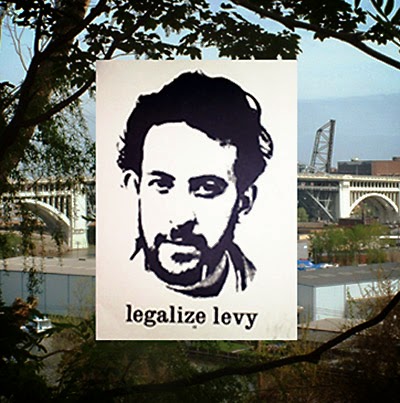 In the early Eighties, Cleveland was still in a transitional period in terms of music. It was and still is a very divisive, often negative and very incestuous scene. You had sort of a musical social-political hangover happening from the 1970s, and even the 1960s. The late Poet Daniel Thompson was our next-door neighbor, and the late/great (underground poet, artist and publisher) d. a. levy’s “Wanted” poster could still be seen on Coventry. The “over-ground” music scene was littered with the usual run-of-the-mill, spoon-fed radio crap. That’s where bands and clubs of that ilk made their money. On the other hand, you had underground bands like Pere Ubu, Pagans, The Easter Monkeys and others and even early hardcore bands like The Dark playing wherever they could get gigs. But there weren’t a great deal of options for original music. The drinking age was still 18 at the time. So there was still a bar scene, but for original music, you had the Phantasy (thank you, Michele Difrasia and family), the Agora (booked by the great Val Seeley), the Mistake (under the Agora, it later became the Pop Shop, booked by Chris Andrews!), the Sports Page, the Pirate’s Cove (thank you Larry Collins and the Ciulla Brothers) and a few others. The college radio stations and their amazing DJs were really the support system for the original music scene – WRUW, WCSB, WOBC, WUJC and others. They almost single-handedly produced and promoted all of the original music shows at the time. Many of us got our first exposure and local careers started by them.
In the early Eighties, Cleveland was still in a transitional period in terms of music. It was and still is a very divisive, often negative and very incestuous scene. You had sort of a musical social-political hangover happening from the 1970s, and even the 1960s. The late Poet Daniel Thompson was our next-door neighbor, and the late/great (underground poet, artist and publisher) d. a. levy’s “Wanted” poster could still be seen on Coventry. The “over-ground” music scene was littered with the usual run-of-the-mill, spoon-fed radio crap. That’s where bands and clubs of that ilk made their money. On the other hand, you had underground bands like Pere Ubu, Pagans, The Easter Monkeys and others and even early hardcore bands like The Dark playing wherever they could get gigs. But there weren’t a great deal of options for original music. The drinking age was still 18 at the time. So there was still a bar scene, but for original music, you had the Phantasy (thank you, Michele Difrasia and family), the Agora (booked by the great Val Seeley), the Mistake (under the Agora, it later became the Pop Shop, booked by Chris Andrews!), the Sports Page, the Pirate’s Cove (thank you Larry Collins and the Ciulla Brothers) and a few others. The college radio stations and their amazing DJs were really the support system for the original music scene – WRUW, WCSB, WOBC, WUJC and others. They almost single-handedly produced and promoted all of the original music shows at the time. Many of us got our first exposure and local careers started by them.
At the time, I met many people who would have profound effects on my life as the years wore on. Some are still with us; many are not. I washed dishes at a place named Club Isabella, where this cat name Jimmy Armstrong used to come in and play the piano after hours. He was like one of the “Dead End Kids” – like Leo Gorcey, if you will – but he knew all the standards and could sing like Sinatra. He used to tell me, “Go to school, kid, learn some history, study music and practice,” so I did. Jimmy passed away last year… I ran into a cat name Bobby, who was dragging his record collection to Record Revolution one day. Turns out he was the guy who put out the great punk compilation Cleveland Confidential. He became a lifelong friend who was instrumental in helping many in the CLE/NEO music scene over the years – but it would take me years to find out just how much. We lost him a year a half ago; he was one of my best friends.
As I was getting my feet wet in the music scene, I was looking for bands to play with. I stumbled across some old friends from the neighborhood who were looking to form a band. After many names and a few personnel changes – including singer Brian Azzarello of comic book fame (100 Bullets, Batman, Hellblazer, Superman) and his replacement, Robert Caruso, now a well-known TV/commercial producer – that band became Johnny Action. During this time, I was making trips to New York to work for a friend and former boarding school mate named Rich Thomas who had moved to NYC from Columbus and formed a rockabilly band with former Pagans drummer Brian Hudson called The Kingpins. I would make sorties up to NYC and “roadie” for his band and started cutting my teeth as a road crew guy.
A few posts back, I sang the praises of Akron’s finest cover band, The Walking Clampetts. I should’ve pointed out that you were in their original lineup, known as Johnny Clampett and the Walkers. The band’s roots were more in rockabilly and surf rock, not punk. How did you end up being their lead singer?
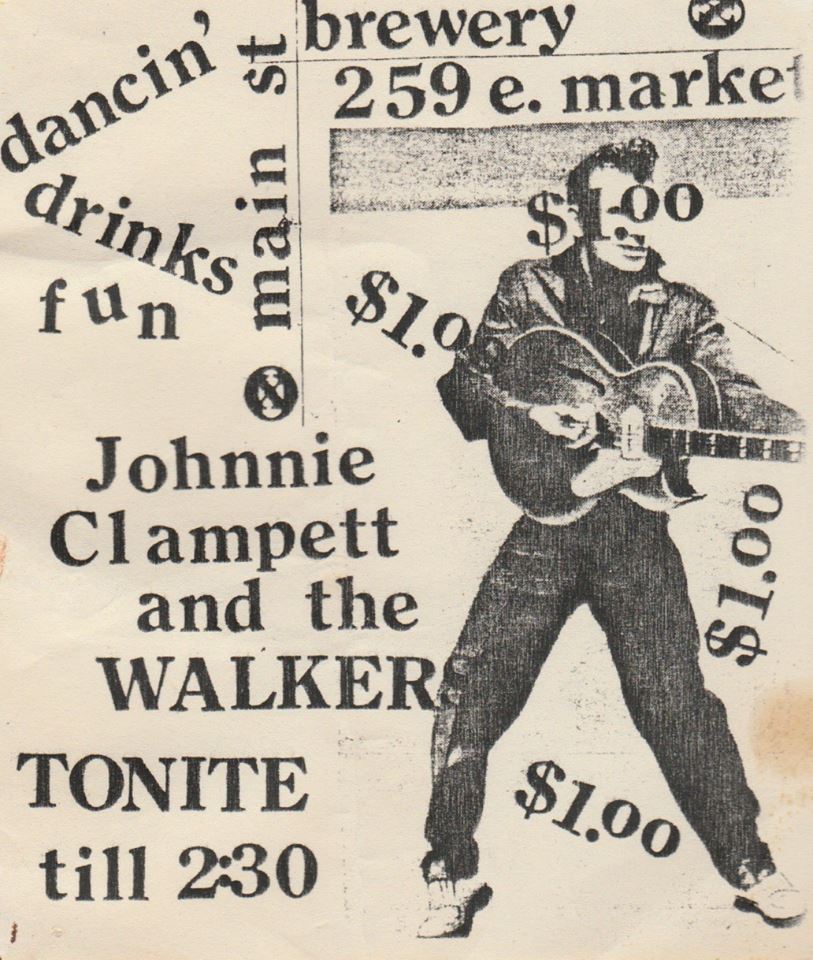 Well, that’s a funny story… I met Bob Basone one day at the old Goodwill down on Mill Street in Akron – around 1981. As a matter of fact, Gordon, myself, Bob, his brother Danny and Jimmy and Danielle from what later became (Akron hardcore band) The Urban Mutants all met at the same time, the same day, around a rack of vintage men’s shirts at that store. I had some big-ass pompadour haircut at the time and Bob liked that, and we got to talking. He said he was in The Red Rocket Gang and they played rockabilly music and that we should check ‘em out. We all became lifelong friends that day. (I ran into Bob again at E.J. Thomas Hall after seeing King Crimson!)
Well, that’s a funny story… I met Bob Basone one day at the old Goodwill down on Mill Street in Akron – around 1981. As a matter of fact, Gordon, myself, Bob, his brother Danny and Jimmy and Danielle from what later became (Akron hardcore band) The Urban Mutants all met at the same time, the same day, around a rack of vintage men’s shirts at that store. I had some big-ass pompadour haircut at the time and Bob liked that, and we got to talking. He said he was in The Red Rocket Gang and they played rockabilly music and that we should check ‘em out. We all became lifelong friends that day. (I ran into Bob again at E.J. Thomas Hall after seeing King Crimson!)
Fast forward to late summer, 1982 – Johnny Action was opening for The F-Models at JB’s Down. Johnny Teagle and Bob Basone saw me play with Johnny Action and the Treadmills. They must’ve liked something they saw in me. Johnny Action broke up a few weeks later when Caruso moved to California to go to film school. I moved back to my folks’ house in Hudson and struck up a friendship with Johnny Teagle and Bob. We started playing and rehearsing in my folks’ living room with Mikey Hammer on drums… I was in heaven! They were very kind to me and took me under their wing. We all exchanged ideas about our different tastes in music, but I learned a lot about guitars and amps from Johnny and bass from Bob… and jeez, Mikey Hammer is one of the best fucking drummers I’ve ever had the honor of playing with anywhere! Not to mention Johnny has an encyclopedic knowledge of surf and instrumental music, so I had the good fortune of making friends with the right people.
Originally, when the band started to play out (before I joined, obviously), I was just kind of a ringer they brought up for a few songs to sing here and there. I’d sing some of the tougher songs so Johnny could riff out – Brand New Cadillac (Vince Taylor, as done by The Clash), Please Give Me Something (by Bill Allen, an Akron native), Joe Bennett and the Sparkletones’ Black Slacks (a duet with Johnny) and songs that were popular at the time, like Rumble in Brighton and Rock This Town by The Stray Cats. Bob used to occasionally go to NYC and hang out for weeks at a time, so I would fill in on bass guitar, including upright bass (which was my parent’s gift to me for graduating from high school). I still have it, and I got quite good at slapping the “old doghouse” bass around. I even got the Clampetts a gig opening for The Kingpins when they came to town… You still with me?
I should mention another person who needs to be remembered here. There was a lovely, sweet girl named Patty Melnis who used to get up and sing I Need a Man (by Barbara Pittman) with the Clampetts at the time. She was a lovely girl who was rather frail… she died a year or so after I left the group. Rest in peace.
You later joined Michael Purkhiser, guitarist/singer for the Clampetts, in the band 3D. You also remain close friends with Purkhiser, brother of the late Erick Lee (aka Lux Interior) of The Cramps. That band’s live show was everything rock ‘n roll should be – loud, dangerous, raunchy, sexy… How would you describe The Cramps’ legacy, and Michael’s influence on your own playing?
Michael is my brother from another mother, as they say. I first saw him in The Action, an amazing band. I later met him toward the end of my tenure in the Clampetts. Of course, everyone knew of his association with The Cramps. It was common knowledge around the Kent/Akron scene that the band had come from these parts. This whole area already had a legendary status as the place that Devo, The Cramps, The Waitresses, Dead Boys, Tin Huey, Rachel Sweet, Chrissie Hynde, Pere Ubu, Pagans and others had come from…The rest of the world had yet to catch up.
More back story… By early 1983, I had left the Clampetts and moved back to Cleveland. The members of The Human Switchboard had been living in my building in Cleveland Heights. They needed a roadie for a two-week east coast trip. I had known them since their days in Kent, OH, when Bob Pfeifer owed and ran a record store there (circa ‘76). I got in the van… took the trip… learned more skills… had fun… When I got back from that, a friend/manager of a local coffee shop was promoting a show with a band from Montreal called Men Without Hats. They had a hit called Safety Dance, and they needed a production manager for their show. I got the call and the gig. This was how I got my start in Cleveland as a roadie/tech/everything guy (as I call myself). The Kingpins came through town again and toured with the Pagans. I went out with their road crew for their Midwest tour, including their opening slot for Lords of the New Church featuring Stiv Bators (of Dead Boys). How many people do you know who can say, I worked for the Pagans? This is also how I got my start working at the Agora.
Back to Michael and the Clampetts… So after I left Johnny Clampett and the Walkers, Michael (fresh from The Action, which broke up at the end of 1982) joined the band and they changed their name to The Walking Clampetts. This was circa 1984, I’m pretty sure…The Clampetts opened up for Brian Setzer when he came to town on his solo tour. I went down and helped out for that show; same thing for when The Cramps came to town (me thinks 1985?). That is how I really got to know Michael and also The Cramps. Meanwhile, the Clampetts became the local “go-to” act around the late Eighties… Whenever they played close to where I was, I’d go see them and get up and sing a couple songs. So I became friends with everyone in the band over time. When The Walking Clampetts first broke up in the early 1990s, I stayed in touch with Michael. I had been touring a lot with bands by that point, and he was looking for roadwork. I would call him about potential gigs, amp repairs and other things. So we would stay in touch – that’s how we eventually started 3D and how I eventually got hired by/with him to work for The Cramps.
When I got off the road with Toadies and the end of 1996, there was kind of a lull in the industry. I had been on the road for 10 straight years, and I wanted a break. Michael had been working with Dave Stephenson (Kal and the Bad Dudes) at 216 Studio in Cuyahoga Falls. I suggested we get the great John Koury from The Infidels (he’s now in The Deadbeat Poets) to play drums, and that became 3D. Well, as you know, Michael is an amazing player. And I was lucky, because he not only wrote great songs for us to play and sing, he BUILT THE AMPS TOO! Michael is a very talented guy and a sweetheart to boot. He can play circles around anyone, but playing with him, Dave and John actually simplified my playing, in the best way possible. Dave Stephenson is an amazing bassist and B-3 player, not to mention a great engineer. The stuff we did with 3D was awesome, but like most bands from this area, we were probably ahead of our time. Perhaps a little too this or that, I don’t know. Some people might call it Americana, but we were probably 15 years ahead of this souped-up country music – which is really just rock and roll, whatever. John Koury is also a fucking great drummer. He has fantastic feel, does the Charlie Watts quarter-note fills (which I love), doesn’t overplay… He’s also a great singer – does wonderful harmonies. We coulda been contenders! (See video at the end of this post.)
The Cramps – legends… Man, what can you say? I wrote about them at length in my master’s thesis. I was lucky to get to work for them. I can’t say I knew them well, but it was very cool to have the opportunity to be part of their world for just a short period of time. Like I said, I first met them back in the Eighties with the Clampetts, then worked for them when they toured with Toadies and White Zombie in the late Nineties. The last time I worked for them was in 1997 – Michael was doing sound and I was doing guitars. I gotta say, Lux was probably the most badass front person I ever saw, hands down. He tore up the joint, and it was for real – it was not for show! I mean, he was doing very dangerous stage performances well into his late 50s. Now, I’ve seen Iggy in his prime, and he was amazing, carnal, primal and even crazy…But after Iggy had stopped doing insane stuff that would’ve killed him, Lux was jumping 15 feet off a PA to mid-stage with a ball-end Shure SM-58 in his mouth and breaking the mic stand in two on the monitor while landing on a bare concrete stage in six-inch high heels, wearing nothing but gold-lame underwear! Un-be-fucking-lievable! That said, he and his wife, Poison Ivy, were lovely people, and I’m grateful I had the opportunity to work for such legends. Musically, they created their own gumbo pot of influences – taking early primitive rock, punk, country, hillbilly and new wave and calling it ”Psychobilly”: The Mad Daddy
They had such a visual impact and influence… You cannot come up with another band that changed the face, look, style and overall image of balls-out rock and roll like The Cramps. I mean, you can see that influence in every tattooed, black-clad, guitar-playing, upright bass-slapping, early rock and roll-loving kid who ever picked up a vinyl 45 Elvis record! From Ivy’s redhead curls and orange 6120 Gretsch guitar to Lux’s black leather gloves and Jack Lord-esque pompadour… Like Betty Page and Gene Vincent to Mad Daddy and Ghoulardi before them, they inspired thousands of punk rockers and new wavers and continue to influence people. They also were the First Couple of Rock and Roll, and their love was undying! Lux Interior, man… inner light!
You’re proud of the work you did with the terrible parade, and I can definitely hear why. The band’s brooding, melodic originals have held up well and wouldn’t sound out of place on contemporary college radio (here’s a taste: China Turns To Dust). When you consider all those lame, heavily promoted MTV hair bands that landed record deals during the Eighties, it seems almost criminal that ttp didn’t break through. What’s your take on that?
The terrible parade was my first real serious band. And yes, I am very proud of what we did and accomplished. We were a very unique-sounding group. I was fortunate… We all managed to find each other at the right moment. They had been a three-piece band and were looking to expand their sound. (Flashback time again… I had moved back to Cleveland after my stint in Johnny Clampett… By this point in my young career – this is late 1983 – I had done those tours with Pagans, The Kingpins and The Human Switchboard and worked for Men Without Hats.) OK, so I joined ttp as their second guitarist, and we began woodshedding (practicing like mad). I met Alan Grandy (the leader and songwriter in the group who was/is like an older brother to me) through the girlfriend of ttp’s bassist Franklin Persuit. The three of us would sit in Alan’s apartment for hours and come up with dueling-chordal arpeggio lead guitar parts that complimented each song, with Franklin weaving in very intricate melodic basslines. Our drummer, Paul Strachan, would come over and play quietly on drum pads and couch cushions so as not to disturb the neighbors. We worked liked this for months even before I played a note live with the band. Alan wrote fantastic songs that had wonderful, timeless melodies. He allowed me to develop and write my own songs with the band. For a while it seemed like we were going to “make it.” I can’t put my finger on one thing or even one specific reason why it didn’t happen, but we weren’t alone. It’s not like anyone in this area really did until Trent Reznor and Nine Inch Nails made it big. Then as soon as he got established, he bailed (and I don’t blame him one bit).
At this time in Northeast Ohio (from about 1980 to about 1990), if you were in a band, didn’t play covers and you weren’t some watered-down Bruce Springsteen, you couldn’t get arrested. In terms of scenes (and press about them), you heard about Athens, Boston, Minneapolis, New York City, Chicago, LA and other fanzine-approved “anointed scenes.” Here, there was a virtual national press blackout, and the local press – other than the wonderful Jane Scott and a handful of other writers – did not write about local bands. And when they did, it was often in the form of a local review of either a new release or a live show. Those usually were comprised of a few scant lines of copy about how a band sounded like the local flavor of the month, and how “with time and some more shows under their belt they might amount to something someday.” Locally, the scenes were made up of competitive, often backstabbing bands that would talk shit about anyone who got a leg up. Remember, at this time you were considered a “sell out” if you had aspirations of getting a record deal or trying to do anything professional.
The parade was the only underground band at the time to have a manager, the first band to record at what became Beat Farm Studios (run by Alan McGinty and Chris Burgess), and the first to release a flexi-disc (so we could send them out in press kits). Again, this was considered professional and frowned upon. We did get great support from the local college radio stations, and that’s probably what sustained us. Many of the clubs that featured local original acts used to actually pay you well when you played there and drew crowds. They also used to pay your band to open for national and international acts… a few hundred dollars for a 45-minute set, almost completely unheard of today. This was before they changed the drinking age to 19 and then to 21, which completely killed the club scene as we knew it. DOA…
Cleveland’s a big town with no centrally located clubs. Once the Agora on East 23rd St burned down (taking the Pop Shop with it) and the Lakefront and Underground closed, there was nothing really left to bring people together. The Pirate’s Cove became Peabody’s Down Under, but the venues became fewer and farther between.
Looking back, unlike a few other bands, the parade had no real connections to the industry (not that there was an “industry” here; there wasn’t). There was no real camaraderie, and there truly was/is a division between the east and west side of Cleveland. We kept on keeping on… Randy Meggitt at After Hours Records put out our EP and we toured on our own. We’d come back to town and try playing more shows. We wrote and recorded more songs, but we had no outlet for all of our material. We tried shopping the tapes… I even acted as the manager for a while. I got bored and started playing in what became the “industrial jazz band” called Death On A Stick (again, that’s another story, but a good one). We got lethargic, and as time passed we kind of lost our way. The industry was changing, and we did too. I can’t blame anyone but ourselves for our own demise… but I will say there were times when I felt we were slighted by the press. We were contemporaries of REM and the Smiths, and to tell you the truth, I never really cared for either of those bands. I mean, I played lead guitar! But we were always fucking compared to them. I’m sorry, but I was more influenced by a band like Wire or Ultravox or Neil F-ing Young or Joy Division (a comparison I’ll gladly accept). But to hear people say “Oh, you sound like REM or The Smiths,” I couldn’t care fucking less… It gets a little old.
You participated in the first two Lollapalooza tours, both as a crew member and auxiliary musician (fans who caught the first tour might remember you playing guitar on Nine Inch Nails’ Head like a Hole). What did you learn from those tours, other than don’t eat the blue pills?
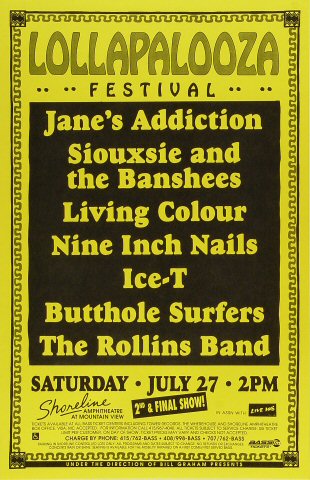 Man oh man… Well, considering how long I’ve been going on here already, I could write a book about these two tours alone. But I’ll try to keep it brief. The first Lolla tour was fun, but it was a great deal of work. I love Trent and I was very fortunate to get to work, tour and play with him. He was very kind to let us share the spotlight with him. The best part of that first tour – and later the European tour with Guns N’ Roses – was being able to play guitar on Head like a Hole. At this point that song had become my calling card!
Man oh man… Well, considering how long I’ve been going on here already, I could write a book about these two tours alone. But I’ll try to keep it brief. The first Lolla tour was fun, but it was a great deal of work. I love Trent and I was very fortunate to get to work, tour and play with him. He was very kind to let us share the spotlight with him. The best part of that first tour – and later the European tour with Guns N’ Roses – was being able to play guitar on Head like a Hole. At this point that song had become my calling card!
I knew Trent from the local scene when he was in Slam Bamboo and The Exotic Birds in Cleveland. He knew I was a musician and a damn good guitar player. I was the first technician they ever hired. My good friend Mark O’Shea had been their tour manager for their first few tours, and when they needed someone to take them up to Chicago to make the video for Head like a Hole, they decided to try me out to see if they’d like me as their “everything” guy. So I drove the band and gear up to Chicago and we made the video with the amazing film and animation company H-Gun. Needless to say, it was gas. I was production assistant on the shoot, ran the smoke machine and helped get Trent down from this harness and rope that they used to hang him upside down/writhing around for the final part of the shoot. This was when MTV was still a video-playing music machine, and it became an instant classic. I spent the next two years as the band’s only stage technician.
Trent is a musical genius – I don’t use those words lightly. He (along with Jeff Connelly of The Lyres… again, another book worth of material) is one of the only people I’ve ever worked with who I can honestly say is the real deal in terms of songwriting, musical ability, vision and profound sense of capturing real emotions. After one of the first shows I worked for him, I was blown away by the intensity. I told him I had no idea just how hardcore the shows were going be. He said, “Prepare for battle.” Indeed.
By the time we got to Lollapalooza 1991, we had all come a long way, but none of us had been to that level before. We had come from playing sold-out shows across the U.S. and Canada, including some 4 to 5 thousand-seaters opening for Jane’s Addiction at Universal Amphitheater. But nothing prepares you for playing in front of 40 thousand large… especially when your gear breaks down. We had some issues with gear I won’t go into here (long story), but Trent breaks a lot of gear, and we had been using a lot of the same stuff from all those small-club tours. You can only fix something so many times before it can’t be fixed anymore.
Once we got those issues taken care of, it was pretty smooth sailing other than the fact Trent smashed his guitars like shit through a goose. Many of my days off were spent getting $2,000 in cash and driving to pawn shops (this was, once again, B.C.). You had to call these places on a landline and see if they were open and what they had, often on a Sunday. You’d buy five recently pawned “hair metal” guitars (remember, around that time, Lollapalooza and Nirvana killed hair bands), drive back to the venue and often not even restring the guitars – just tune them up and hand them to whoever wanted one. (Ice-T to me: “Marky Ray, I wanna smash a guitar”… Me: “Uh, gee Ice, I only got one left…Trent’s manager John Malm, angrily: “Marky Ray, give Ice-T a guitar!”… Me: “Eh, OK”… Ice-T: Smash!!)
Those early Lollapalooza tours were like touring with 300 of your best friends… I made friends for life with The Rollins Band (who I shared a tour bus with), Butthole Surfers, Jane’s Addiction, Ice-T+Body Count, Living Colour, Siouxsie and the Banshees and all the bands’ crews as well. On Lolla ’92, Ministry killed (almost literally – 120 DB in the sidefills… my ears still ring). I did guitars for Al Jourgensen, the late Mike Scaccia (utterly amazing guitarist and a wonderful person; RIP), and Sam Ladwig. We had an incredible band and crew – many people I’m still really close with. I became very good friends with Pearl Jam, who let me sing backup vocals with them on covers of Sonic Reducer (Rocket from The Tombs, Dead Boys) and Rocking in the Free World (Neil Young); and Soundgarden, who let me sing backup on Outshined, often with Eddie Vedder. The bands Lush and The Jesus and Mary Chain liked my voice so much they asked me to introduce them. Lush had seen me with NIN in London… I used to do “Monster Truck”-type intros for NIN at Trent’s request – he loved the whole “wheels spinning at over 200 miles an hour” bit. By that point in my career I had already seen the Red Hot Chili Peppers a bunch of times, and I knew them pretty well. I became really good friends with their crew and toured with the band a number of times… good people! I met Jim Rose on Lolla ’92, and that began another journey…
Quick backstory on Butthole Surfers. My band Death On A Stick opened for the Surfers in 1987 at the Newport in Columbus, so when I did Lolla’ 91 we were already friends. They said “If we ever get the money to hire a tech, we’re gonna hire you,” and they did. Fast-forward to 1993: BHS were betting ready to tour in support of their Independent Worm Saloon LP (produced by John Paul Jones of Led Zep). The week after I accepted the world tour, the late Jim Jones of Pere Ubu calls me… ”Marky, Tony (Maimone) is leaving the group… We’d like you to replace him on bass.” Fuck! That was one of the hardest things I ever had to do. I loved Jimmy (everyone did), but I’m a man of my word and had committed to working with BHS. Looking back, I don’t think I made the wrong move. The Surfers ended up touring that year with Stone Temple Pilots, Firehose, Basehead, The Flaming Lips, Boredoms, Pearl Jam… and we did the last U.S. tour with Nirvana. Not a bad year. Jim Rose approached me on the last night of the Nirvana tour: “Marky Ray, what are you doing in about two weeks?” Scandinavia here I come…
Most hard-core music buffs like to tell you about all the legendary shows they’ve seen over the years. I’m more a man of regret, having missed Cream at the Akron Civic, Devo at JB’s in Kent, and the Jim Rose Circus Sideshow, which stopped in Cleveland several times. Tell us about the Rose tour and the “Bed of Swords” stunt you performed as the Zenmaster…
We were in Helsinki, Finland – I was tour managing on what was the last tour of the original Jim Rose Circus Sideshow when Jim asked me if I’d like to join the Circus (Matt The Tube and The Torture King were leaving). Jim knew I was a frustrated musician who was looking to perform. So when we got back to the states, I ran away and joined the Circus!
I moved to Seattle for rehearsals, and we reconvened with some newer members. I became their Tour Managing Guitar Playing Axe Wielding Bed Of Blades Laying Human Chopping Block “Zen Master” Marky Ray. Jim taught me how to do the “Bed Of Blades.” It’s basically just Martial Arts… Practice makes perfect, but it can kill you – and it almost did on a couple of occasions (amazingly, he let his wife Bebe do it too!). We put the show together, with Jim serving as Carnival “Talker” (it’s talker, not barker), and The Enigma and I redid a lot of show music and formed it into a tight soundtrack to accompany all of the acts.
We did a “B” level (all the smaller markets) tour of Canada and then the southwest U.S. to get our shit together, and then we went to Australia and later the Edinburgh Fringe Festival (this is 1994). Trent eventually called and asked us to open for him on the NIN “Downward Spiral Tour” (Marilyn Manson was Jim Rose’s opening act). I later learned the “Chinese Execution” stunt (about mid-tour), where they chopped a Casaba melon in two on the back of my neck with a machete. The Enigma came up with that stunt. Again, the first few times, no problem… but the first time on stage I cut my shoulder open. You gotta be careful. I also was a member of the “Chainsaw Stunt Team”… During our last show in Australia, I ran into Mark The Knife’s chainsaw as he was juggling it. It nearly took my arm off.
So now you’re more in the academic realm, training the next generation of stagehands, producers and tour managers. Have those skill sets changed significantly over the years, or is it still just a matter of paying attention to the details and making sure the trains run on time?
Stagehand work overall has not changed considerably – but a lot of the technology has changed. There are more skills required for working with newer gear. Automation in the staging areas as well as the equipment to run these newer pieces of gear require a level of proficiency and training. But the basics of stagehand work go back generations. Although theater is different from rock and roll, many of these newer productions have become intertwined into mostly the same thing – using or deploying many of the same operations, mechanisms and production techniques.
Now that we are in the A.D. (After Digital), a ton has changed in the area of tour management. I show my students these hand-written notes I have from 30 years ago. I also have faxed contracts with my “advance” notes on them. Yes, in B.C., we had to do everything long-form – hand-written or typed, Xerox copies, bound or stapled… Now you can manage a tour with your smart phone, tablet or a laptop (though I always recommend having hard-copy backups for safekeeping against theft, or if you drop the damn thing in the toilet… and I always have a backup thumbdrive).
A final note about stage craft… They have apps now that let you run your show, or front-of-house console, from your phone, tablet or laptop. You can focus your lights on stage, change and store presets, pretty much do anything you want. That goes for audio, lights and video. Technology is incredible. In 1995, I was on the road talking with the great Paul Roessler (45 Grave, Josie Cotton Band, many others), who was playing keyboards in Prick – one of Trent’s opening acts at the time. We were pondering things like, “Can you imagine someday you are going to be able to download a whole album from the Internet? Wow!” LOL.
Things also have changed a great deal for studio producers in the digital world. With the advent of digital technology – Pro Tools, software, plug-ins, virtual instruments – you can do anything with a smart phone, tablet, computer and laptop. But the fact remains, you should at least have a modicum of talent and be able to play something. But in this day and age, it’s not always the case, is it? I still prefer analog myself, at least when it comes to vintage gear. But that’s another story….
School of Rock: Marky also stays busy giving his musician/students hands-on recording experience through Tri-C’s Studio Lab Band (aka The SLAB Band). On this cut, the band covers The F-Models’ Can’t Relate (RCR friend Chase Papajcik plays 2nd guitar). The Kent-based punk band was a big inspiration to Marky: “I’ve tried to keep (frontman) Robert ‘Ig Nition’ Morningstar’s music alive by having my students record his songs”: Can’t Relate
Here’s a very Eighties and very NE Ohio video… 3D – Automatic Man:



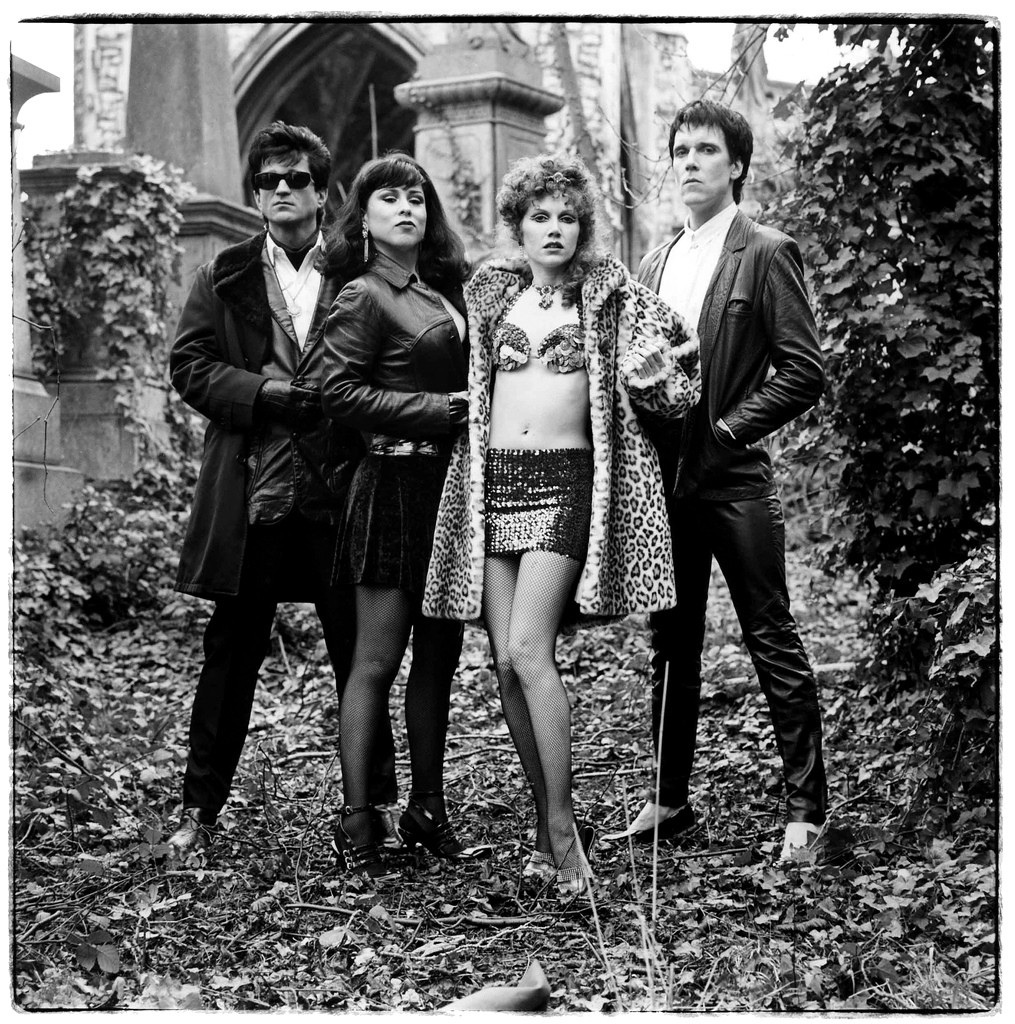
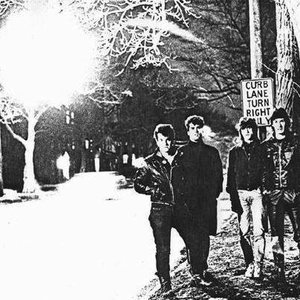
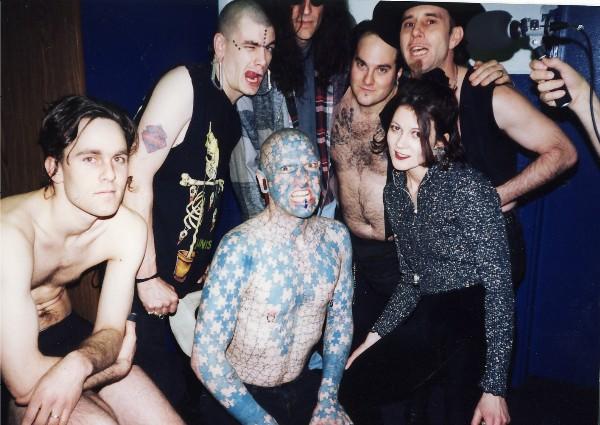

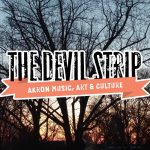
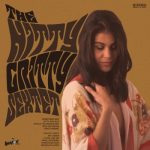
Very interesting, albeit way too long! I had to stop for a caffeine boost in the middle. Seriously, these back stories are interesting. Do you ever read the Oxford American music issues? They devote one issue per year to the music of a single state; so far Texas, Arkansas, Tennessee, etc.
BTW, this is in no way related to the discussion at hand, but I came across this today…my favorite James Brown tune ever.
https://www.youtube.com/watch?v=0QbEd9cuRBI
I’m glad you stuck with it. Yes, Marky Ray has a lot to say. And I just decided to let him go… Seemed like any discussion of that time in rock history and those bands/influences should be every bit as unfiltered as Marky himself. I didn’t live that life, but I saw the Pagans and the Cramps back in the day, and a conversation with Marky is as close as it gets to reliving those experiences (loved his description of Lux Interior’s no-holds-barred stage persona). Thanks for sharing that James Brown tune. Never heard the studio version — only the balls-out live recording at The Apollo. It’s kind of a revelation hearing the “cooler” take. Not better… just another side of James, and you can never have too much JB. Re: Oxford American, I’m not sure how they’d boil down Ohio. Between punk (mostly NE) and rock/soul/funk (mostly SW: King Records, Lonnie Mack, Robert Ward, Roger Troutman, The Ohio Players), that’s a lot of turf to cover.
Thumbs up!
Mike P is so under appreciated! Dan Johnson piece would be a great read. Just visited Millidgeville Thought of rcr Safe travels
That’s a great idea Mike. I’ve known Dan for a long time… he worked on a couple of my guitars back when I was playing in your club. Really enjoyed the video he did describing all of Dan A’s gear. I was never much of a pedal guy, but I’m fascinated by all the little gadgets guitarists use to trick up their sound on stage. Have you seen the Black Keys’ mini-doc on rollingstone.com? Nice shot of the Barnburners playing the North Side!
Just saw rolling Stone film. All this couldn’t happen to two nicer musicians. Dan was my tenant in his Guitar Garage. He is an incredible player himself Another idea for a regional piece might be Walkin Cane. He is our blues man Mantle of r jr Lockwood passed to him. Trust all well. Back in north and been to gar hall mostly. Great venue. C u